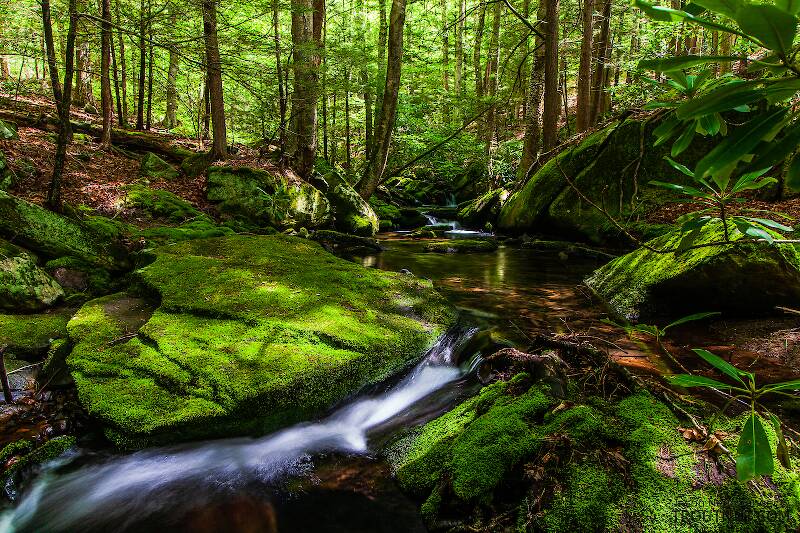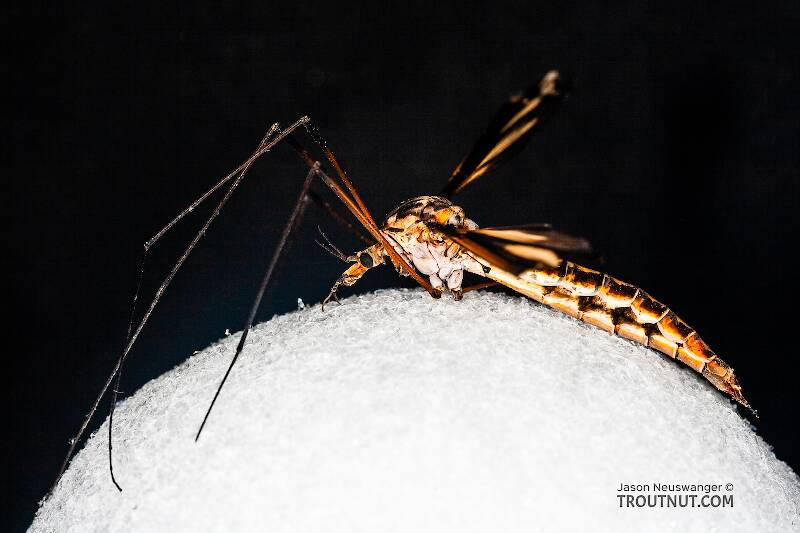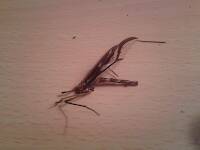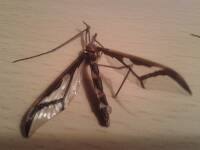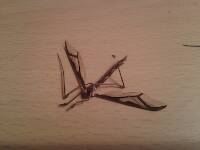
Blue-winged Olives
Baetis
Tiny Baetis mayflies are perhaps the most commonly encountered and imitated by anglers on all American trout streams due to their great abundance, widespread distribution, and trout-friendly emergence habits.
Featured on the forum

This one pretty clearly keys to Kogotus, but it also looks fairly different from specimens I caught in the same creek about a month later in the year. With only one species of the genus known in Washington, I'm not sure about the answer to this ID.

Troutnut is a project started in 2003 by salmonid ecologist Jason "Troutnut" Neuswanger to help anglers and
fly tyers unabashedly embrace the entomological side of the sport. Learn more about Troutnut or
support the project for an enhanced experience here.
RleeP on Feb 25, 2010February 25th, 2010, 1:02 pm EST
It can vary from 14 to 18 depending upon the specific insect and the type of fly. A good crane fly pattern is the one developed by Ross Mueller. It's tied on an 18 and uses over size hackles. You could probably google it and find it
Wbranch on Feb 25, 2010February 25th, 2010, 10:20 pm EST
I read somewhere, maybe on this web site, that the adult cranefly is normally of very little importance to the fly fisher. However the larvae is very important as it gets dislodged from its moorings during high water events. Google "Walt's Worm" for a decent imitation.
Here is one way I tie it;

Here is another version with tying recipe for both - photo is a bit dark - but you can get the idea.

Here is one way I tie it;

Here is another version with tying recipe for both - photo is a bit dark - but you can get the idea.

Catskill fly fisher for fifty-five years.
JOHNW on Feb 26, 2010February 26th, 2010, 2:03 am EST
I agree that the adult is usually of minor importance however on some streams the fish go nuts for them even though the emergence is relatively sporadic.
Try some yellow soft hackles in 14-18 or an oversized "skater" style dry in 16-18. The takes when they are on these bugs looks like a rise to emerging caddis but more explosive.
JW
Try some yellow soft hackles in 14-18 or an oversized "skater" style dry in 16-18. The takes when they are on these bugs looks like a rise to emerging caddis but more explosive.
JW
"old habits are hard to kill once you have gray in your beard" -Old Red Barn
Oldredbarn on Feb 26, 2010February 26th, 2010, 4:58 am EST
"I read somewhere, maybe on this web site, that the adult cranefly is normally of very little importance to the fly fisher." -Matt
Hmmm...
Hey everyone if Mr. W Branch has a couple versions he ties...I don't think it's just for fun or an accident...I think he knows more, about their importance to the trout, than he's completely telling us and he probably has the pictures somewhere to prove it to us! I sense a smile somewhere behind that quote of his above...A knowing smile.
All I know is, it's a rare time indeed, when I sit on a river bank somewhere, that I don't look down at my waders and...Hmmm...Looks like crane-fly larve...There must be a secret out there somewhere that explains how dinky brookies become 10"+ brookies...I think it went something like, "Never let any food pass you by...Or nab it before your cousin does."
Thanks Matt...Now you can explain to the rest of us how you post pictures in the middle of a thread...I always thought you had to go through the "Photo Board"...
By-the-way...What size you tying those things on?
Spence
Hmmm...
Hey everyone if Mr. W Branch has a couple versions he ties...I don't think it's just for fun or an accident...I think he knows more, about their importance to the trout, than he's completely telling us and he probably has the pictures somewhere to prove it to us! I sense a smile somewhere behind that quote of his above...A knowing smile.
All I know is, it's a rare time indeed, when I sit on a river bank somewhere, that I don't look down at my waders and...Hmmm...Looks like crane-fly larve...There must be a secret out there somewhere that explains how dinky brookies become 10"+ brookies...I think it went something like, "Never let any food pass you by...Or nab it before your cousin does."
Thanks Matt...Now you can explain to the rest of us how you post pictures in the middle of a thread...I always thought you had to go through the "Photo Board"...
By-the-way...What size you tying those things on?
Spence
"Even when my best efforts fail it's a satisfying challenge, and that, after all, is the essence of fly fishing." -Chauncy Lively
"Envy not the man who lives beside the river, but the man the river flows through." Joseph T Heywood
"Envy not the man who lives beside the river, but the man the river flows through." Joseph T Heywood
JAD on Feb 26, 2010February 26th, 2010, 5:18 am EST
(The takes when they are on these bugs looks like a rise to emerging caddis but more explosive.
JW)
I agree with John on this---I've been fooled more than once. In July look for the hatching fly in the smaller sizes,22 to no see oms.
Best
JAD
JW)
I agree with John on this---I've been fooled more than once. In July look for the hatching fly in the smaller sizes,22 to no see oms.
Best
JAD
They fasten red (crimson red) wool around a hook, and fix onto the wool two feathers which grow under a cock’s wattles, and which in colour are like wax.
Radcliffe's Fishing from the Earliest Times,
Wbranch on Feb 26, 2010February 26th, 2010, 5:42 am EST
To tell you the truth I don't know what size those hooks are. I got them years ago and they are the only TMC 200R hooks I have. They are 1.0" long from the end of the eye to the fullest part of the radius on the bend. They look to be about a #12.
I've explained quite a few times how to post a pic in an existing thread. Maybe others know a faster method but here is how I do it.
First you need a Photobucket account, or some other web based photograph storing/sharing site, then when you have opened your "Home" page there will be a window that says "Upload". Go to wherever you have your picture stored (I have most of mine in My Pictures in my computer) and select the picture you want to upload. Then click Upload. After 20-30 seconds the picture will be on your new Photobucket account. There are four dialog boxes under the picture. I have no idea what they say but go to the fourth one and highlight it, then go to the tool bar and click on "Edit", then click "Copy".
Now go back to Troutnut.com and start your post then when you want to insert the picture just go to a space below the body of your post and right click and put the cursor on "Paste". Then you'll see a whole string of alpha characters. At the very beginning you'll see at the end of the string. Just go in and change the upper case IMG characters to lower case and submit the post and the picture will appear.
at the end of the string. Just go in and change the upper case IMG characters to lower case and submit the post and the picture will appear.
It is much easier to do than it is to write the explanation.
I've explained quite a few times how to post a pic in an existing thread. Maybe others know a faster method but here is how I do it.
First you need a Photobucket account, or some other web based photograph storing/sharing site, then when you have opened your "Home" page there will be a window that says "Upload". Go to wherever you have your picture stored (I have most of mine in My Pictures in my computer) and select the picture you want to upload. Then click Upload. After 20-30 seconds the picture will be on your new Photobucket account. There are four dialog boxes under the picture. I have no idea what they say but go to the fourth one and highlight it, then go to the tool bar and click on "Edit", then click "Copy".
Now go back to Troutnut.com and start your post then when you want to insert the picture just go to a space below the body of your post and right click and put the cursor on "Paste". Then you'll see a whole string of alpha characters. At the very beginning you'll see
It is much easier to do than it is to write the explanation.
Catskill fly fisher for fifty-five years.
Oldredbarn on Feb 26, 2010February 26th, 2010, 5:58 am EST
"At least 4256 species of crane flies have been described. This makes the Tipulidae the largest family of Diptera."
Need we say more? When we think of a "midging trout" or a "smutting trout" there may be a good chance, based on the statistic mentioned above, that he's dining on crane flies...I don't know this for certain, the entomolgist boys will straighten me out here, but I would imagine that the "hatching" process is sometimes similar to the Dipterans and they dangle attached to the surface film and pop out of their "shuck" and onto the surface tension and off they go.
On the stocked pond I fish in April we get quite the midge hatches. There is one that I think everyone has seen which looks like a mosquito and it's antenna looks like two small paddles...I think the slang for them might be "Duck Fly"...Anyway, I have watched them emerge and they look just like one of those slow motion films of a bean pod growing...It comes straight up out of the water until the legs are free etc and then it tips over on to it's legs, standing on the waters surface, and somehow sheds the husk...Trout love them! They motor around the pond sucking them in with their dorsal fin above the water...
Spence
Need we say more? When we think of a "midging trout" or a "smutting trout" there may be a good chance, based on the statistic mentioned above, that he's dining on crane flies...I don't know this for certain, the entomolgist boys will straighten me out here, but I would imagine that the "hatching" process is sometimes similar to the Dipterans and they dangle attached to the surface film and pop out of their "shuck" and onto the surface tension and off they go.
On the stocked pond I fish in April we get quite the midge hatches. There is one that I think everyone has seen which looks like a mosquito and it's antenna looks like two small paddles...I think the slang for them might be "Duck Fly"...Anyway, I have watched them emerge and they look just like one of those slow motion films of a bean pod growing...It comes straight up out of the water until the legs are free etc and then it tips over on to it's legs, standing on the waters surface, and somehow sheds the husk...Trout love them! They motor around the pond sucking them in with their dorsal fin above the water...
Spence
"Even when my best efforts fail it's a satisfying challenge, and that, after all, is the essence of fly fishing." -Chauncy Lively
"Envy not the man who lives beside the river, but the man the river flows through." Joseph T Heywood
"Envy not the man who lives beside the river, but the man the river flows through." Joseph T Heywood
JAD on Feb 27, 2010February 27th, 2010, 4:23 am EST
I hope this helps
First you need a Photobucket account, or some other web based photograph storing/sharing site, then when you have opened your "Home" page there will be a window that says "Upload". Go to wherever you have your picture stored (I have most of mine in My Pictures in my computer) and select the picture you want to upload. Then click Upload. After 20-30 seconds the picture will be on your new Photobucket account. There are four dialog boxes under the picture. I have no idea what they say but go to the fourth one and highlight it, then go to the tool bar and click on "Edit", then click "Copy".
Now go back to Troutnut.com and start your post then when you want to insert the picture just go to a space below the body of your post and right click and put the cursor on "Paste". Then you'll see a whole string of alpha characters. At the very beginning you'll see at the end of the string. Just go in and change the upper case IMG characters to lower case and submit the post and the picture will appear.
at the end of the string. Just go in and change the upper case IMG characters to lower case and submit the post and the picture will appear.

img----------------------------------------------------------img
Re copy and then past to Troutnut.
I put the two posts together This might help. And by the way this also works for the PM we all send. I deleted some of the letters from above so this would not post a picture.
Best
JAD
First you need a Photobucket account, or some other web based photograph storing/sharing site, then when you have opened your "Home" page there will be a window that says "Upload". Go to wherever you have your picture stored (I have most of mine in My Pictures in my computer) and select the picture you want to upload. Then click Upload. After 20-30 seconds the picture will be on your new Photobucket account. There are four dialog boxes under the picture. I have no idea what they say but go to the fourth one and highlight it, then go to the tool bar and click on "Edit", then click "Copy".
Now go back to Troutnut.com and start your post then when you want to insert the picture just go to a space below the body of your post and right click and put the cursor on "Paste". Then you'll see a whole string of alpha characters. At the very beginning you'll see
img----------------------------------------------------------img
Re copy and then past to Troutnut.
I put the two posts together This might help. And by the way this also works for the PM we all send. I deleted some of the letters from above so this would not post a picture.
Best
JAD
They fasten red (crimson red) wool around a hook, and fix onto the wool two feathers which grow under a cock’s wattles, and which in colour are like wax.
Radcliffe's Fishing from the Earliest Times,
JOHNW on Feb 27, 2010February 27th, 2010, 10:40 am EST
Spence,
Acouple thoughts
On the number of "cranefly species": I was under the impression that while there is a mindboggling # of these many are terrestrial in nature and therefore not of great importance to us flyfishers.
On the issue of the number of patterns Matt caries I would wager dollars to donuts that they are weighted heavily to the subsurface larval stage.
Some other patterns to tie:
Louis HAiry Honey Bug- Search the archived threads (I have gone to this as my exclusive for any Cranefly larva larger than a #12)
Walts worm- nymph hook of choice #8-18, lead wire wrappped on shank, tan hares ear dubbing dubbed in a cigar shape.
Both of these can be tied with or without bead heads. For me the most important part of these flies is I can crank out a half dozen in less than 15 minutes. I always weight them as I will use then as an anchor fly in my team of nymphs but that is a different thread all together.
JW
Acouple thoughts
On the number of "cranefly species": I was under the impression that while there is a mindboggling # of these many are terrestrial in nature and therefore not of great importance to us flyfishers.
On the issue of the number of patterns Matt caries I would wager dollars to donuts that they are weighted heavily to the subsurface larval stage.
Some other patterns to tie:
Louis HAiry Honey Bug- Search the archived threads (I have gone to this as my exclusive for any Cranefly larva larger than a #12)
Walts worm- nymph hook of choice #8-18, lead wire wrappped on shank, tan hares ear dubbing dubbed in a cigar shape.
Both of these can be tied with or without bead heads. For me the most important part of these flies is I can crank out a half dozen in less than 15 minutes. I always weight them as I will use then as an anchor fly in my team of nymphs but that is a different thread all together.
JW
"old habits are hard to kill once you have gray in your beard" -Old Red Barn
RleeP on Feb 28, 2010February 28th, 2010, 3:27 am EST
>>I agree that the adult is usually of minor importance however on some streams the fish go nuts for them even though the emergence is relatively sporadic.>>
Yup..
I tend to think that the sporadic nature of most cranefly emergence is often more than compensated for by the duration of their availability on the water, at least where I've spent the majority of my fishing time, in SW WI and all through the western 3/4 of PA.
Another factor in cranefly importance is that often, some of the most significant cranefly emergences often peak during the so-called "hatch gap" in the first part of May (in PA and SW WI, again...). After the grannom/blue quill/olives but before the sulfurs, etc.
But obviously, YMMV and in general, of course, it is a fly fisher's conceit to assume that most of what we offer up is actually taken by the fish for what WE think it imitates.
To them, it may just look like SOMETHING good to eat and not neccessarily the specific SOMETHING we think they are looking for...:)
Yup..
I tend to think that the sporadic nature of most cranefly emergence is often more than compensated for by the duration of their availability on the water, at least where I've spent the majority of my fishing time, in SW WI and all through the western 3/4 of PA.
Another factor in cranefly importance is that often, some of the most significant cranefly emergences often peak during the so-called "hatch gap" in the first part of May (in PA and SW WI, again...). After the grannom/blue quill/olives but before the sulfurs, etc.
But obviously, YMMV and in general, of course, it is a fly fisher's conceit to assume that most of what we offer up is actually taken by the fish for what WE think it imitates.
To them, it may just look like SOMETHING good to eat and not neccessarily the specific SOMETHING we think they are looking for...:)
Wbranch on Feb 28, 2010February 28th, 2010, 4:26 am EST
"On the issue of the number of patterns Matt caries I would wager dollars to donuts that they are weighted heavily to the subsurface larval stage."
My fly box contains four larvae patterns and zero adult patterns. In forty plus years of FF I've never seen a trout come to the surface to eat a winged crane fly.
My fly box contains four larvae patterns and zero adult patterns. In forty plus years of FF I've never seen a trout come to the surface to eat a winged crane fly.
Catskill fly fisher for fifty-five years.
Martinlf on Feb 28, 2010February 28th, 2010, 10:39 am EST
Hey Matt, you're just fishing the wrong streams, my friend. :) One of the streams you sometimes fish in the spring for olives has seen its pressured wild browns go nuts over dry cranefly patterns in the fall. If you hit it just right. (I just looked and JohnW mentions this phenomena above. I'll bet he and I are thinking of the same stream.) I was surprised by this myself when a friend cued me in, gave me some flies, and sent me there. I had a great couple of days that autumn. I haven't hit it since, and he's had some disappointments other times, so it can vary. I've also taken fish on the J that were feeding on dry craneflies. But that's another story.
"He spread them a yard and a half. 'And every one that got away is this big.'"
--Fred Chappell
--Fred Chappell
JOHNW on Feb 28, 2010February 28th, 2010, 12:31 pm EST
Louis,
I have two very specific streams in mind, both of which you and I have fished together and one of which I'm sure Matt fishes from time to time.
Speaking of fishing together I'm getting a hankering for some celery if the weather would just cooperate. ;)
JW
I have two very specific streams in mind, both of which you and I have fished together and one of which I'm sure Matt fishes from time to time.
Speaking of fishing together I'm getting a hankering for some celery if the weather would just cooperate. ;)
JW
"old habits are hard to kill once you have gray in your beard" -Old Red Barn
JAD on Feb 28, 2010February 28th, 2010, 2:54 pm EST
Jw a little Celery in March is a good thing, try that Stewart blk Spider.
Best
JAD
Best
JAD
They fasten red (crimson red) wool around a hook, and fix onto the wool two feathers which grow under a cock’s wattles, and which in colour are like wax.
Radcliffe's Fishing from the Earliest Times,
Wbranch on Feb 28, 2010February 28th, 2010, 5:03 pm EST
Louis writes;
"Hey Matt, you're just fishing the wrong streams, my friend."
Yes, I guess so, but I'm not about to leave streams that give up at least two dozen over 20" browns each season.
"Hey Matt, you're just fishing the wrong streams, my friend."
Yes, I guess so, but I'm not about to leave streams that give up at least two dozen over 20" browns each season.
Catskill fly fisher for fifty-five years.
Martinlf on Mar 2, 2010March 2nd, 2010, 12:59 am EST
I never thought you would. :)
"He spread them a yard and a half. 'And every one that got away is this big.'"
--Fred Chappell
--Fred Chappell
Quick Reply
Related Discussions
Topic
Replies
Last Reply

